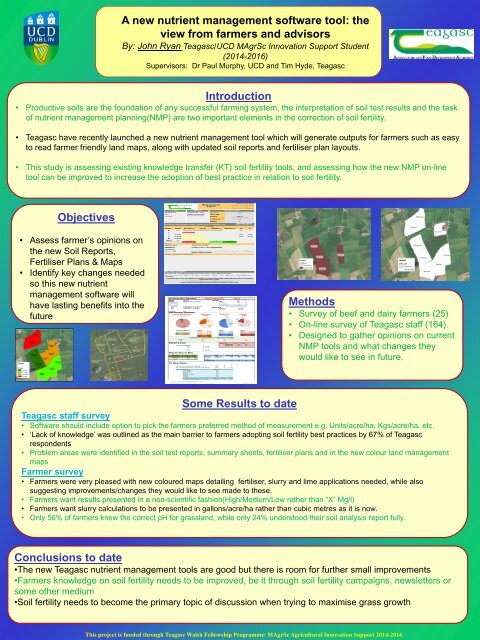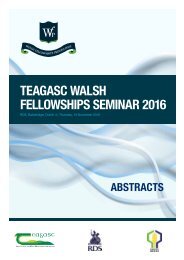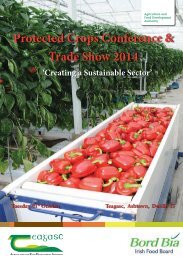Driving Farm Innovation through Knowledge Transfer
1S93ppX
1S93ppX
Create successful ePaper yourself
Turn your PDF publications into a flip-book with our unique Google optimized e-Paper software.
A new nutrient management software tool: the<br />
view from farmers and advisors<br />
By: John Ryan Teagasc/UCD MAgrSc <strong>Innovation</strong> Support Student<br />
(2014-2016)<br />
Supervisors: Dr Paul Murphy, UCD and Tim Hyde, Teagasc<br />
Introduction<br />
• Productive soils are the foundation of any successful farming system, the interpretation of soil test results and the task<br />
of nutrient management planning(NMP) are two important elements in the correction of soil fertility.<br />
• Teagasc have recently launched a new nutrient management tool which will generate outputs for farmers such as easy<br />
to read farmer friendly land maps, along with updated soil reports and fertiliser plan layouts.<br />
• This study is assessing existing knowledge transfer (KT) soil fertility tools, and assessing how the new NMP on-line<br />
tool can be improved to increase the adoption of best practice in relation to soil fertility.<br />
Objectives<br />
• Assess farmer’s opinions on<br />
the new Soil Reports,<br />
Fertiliser Plans & Maps<br />
• Identify key changes needed<br />
so this new nutrient<br />
management software will<br />
have lasting benefits into the<br />
future<br />
Methods<br />
• Survey of beef and dairy farmers (25)<br />
• On-line survey of Teagasc staff (164).<br />
• Designed to gather opinions on current<br />
NMP tools and what changes they<br />
would like to see in future.<br />
Some Results to date<br />
Teagasc staff survey<br />
• Software should include option to pick the farmers preferred method of measurement e.g. Units/acre/ha, Kgs/acre/ha. etc.<br />
• ‘Lack of knowledge’ was outlined as the main barrier to farmers adopting soil fertility best practices by 67% of Teagasc<br />
respondents<br />
• Problem areas were identified in the soil test reports, summary sheets, fertiliser plans and in the new colour land management<br />
maps<br />
<strong>Farm</strong>er survey<br />
• <strong>Farm</strong>ers were very pleased with new coloured maps detailing fertiliser, slurry and lime applications needed, while also<br />
suggesting improvements/changes they would like to see made to these.<br />
• <strong>Farm</strong>ers want results presented in a non-scientific fashion(High/Medium/Low rather than “X” Mg/l)<br />
• <strong>Farm</strong>ers want slurry calculations to be presented in gallons/acre/ha rather than cubic metres as it is now.<br />
• Only 56% of farmers knew the correct pH for grassland, while only 24% understood their soil analysis report fully.<br />
Conclusions to date<br />
•The new Teagasc nutrient management tools are good but there is room for further small improvements<br />
•<strong>Farm</strong>ers knowledge on soil fertility needs to be improved, be it <strong>through</strong> soil fertility campaigns, newsletters or<br />
some other medium<br />
•Soil fertility needs to become the primary topic of discussion when trying to maximise grass growth<br />
This project is funded <strong>through</strong> Teagasc Walsh Fellowship Programme: MAgrSc Agricultural <strong>Innovation</strong> Support 2014-2016




